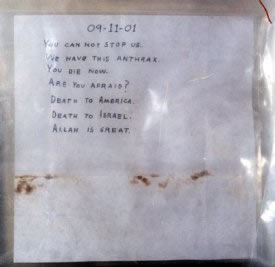Introduction to Biological Weapons
Contents
- Introduction to Biological Weapons
- Biological Weapon Production
- The BTWC
- Original U.S. Interpretation
- Debate about the NBACC
Introduction to Biological Weapons
Biological weapons (BWs) deliver toxins and microorganisms, such as viruses and bacteria, so as to deliberately inflict disease among people, animals, and agriculture. Biological attacks can result in destruction of crops, temporarily discomforting a small community, killing large numbers of people, or other outcomes.
The way that a biological weapon is used depends on several factors. These include: the agent itself; its preparation; its durability in the environment; and route of infection. Some agents can be disbursed as an aerosol, which can be inhaled or can infect a susceptible spot on the skin, like a cut or wound. Attackers can also contaminate food or water with some agents.

Anthrax letter addressed to former Senator Tom Daschle in 2001. (Source: FBI)
Biological weapons have a long history of use. In 1346, the invading Tartar army catapulted the bodies of plague victims into the Crimean Peninsula city of Kaffa and infected its citizens. In 1763, British troops under General Jeffrey Amherst gave the Delaware Indians blankets used by people with smallpox, possibly infecting the susceptible native population. Japan contaminated food and released plague-infected ticks during their conflict with China during World War II. The 2001 anthrax letter attacks in the United States infected 22 people and killed five.
Several differences set BWs apart from other weapons of mass destruction like nuclear and chemical weapons. The release of an agent is not immediately detectable. There are systems that detect biological agents, but most have a delay between acquiring the agent and identifying it.
The effects of an attack also are not immediately detectable. People may become exposed to an agent soon after its release, but the infection requires time to cause illness (the incubation period). Thus, one of the first indicators of a BW attack could be disease outbreaks.
The effect of BWs, disease, can continue after its release. If a transmissible agent, such as the smallpox or Ebola virus, infects a person at the site of its release, that person could travel and spread the agent to others. This would result in secondary infections at areas far from initial release and unprepared for the disease.
Two treaties have placed restrictions on biological weapons. The 1925 Geneva Protocol prohibits the use of chemical and biological weapons in warfare. Some signing countries declared that they would not honor it if their enemies, or the allies of their enemies, did not adhere to its prohibitions. The United States ratified the Protocol in 1975 after President Richard Nixon renounced the use of biological weapons in 1969.
The 1972 Biological and Toxin Weapons Convention restricts countries from developing, producing, stockpiling, or acquiring biological agents, weapons, and equipment outside of peaceful purposes. However, some signatory countries may be continuing weapons development, as the former Soviet Union did before its massive program was discontinued in 1992.
Although developing and using biological weapons once required support by nations, recent advances in biotechnology have made it easier to develop dangerous viruses, bacteria, and toxins with fewer resources. This has increased concerns that individuals and groups could resort to bioterrorism to attack a population.
Biological Weapon Production
Biological weapon production can be divided into several, general stages: 1) A biological agent must first be chosen and acquired. In the case of toxins, the production method must be acquired. 2) After growing and multiplying to sufficient quantities, various selection and modification procedures can alter certain traits and characteristics of the microorganism. 3) The agent is then prepared for delivery.
Choosing an agent requires matching the desired results of an attack with an agent's characteristics. Those characteristics may include: how much of an agent can cause disease (pathogenicity); time between exposure and illness (incubation period); how debilitating the resulting disease is (virulence); its lethality; and how readily the disease spreads to others (transmissibility). Countermeasures to the disease such as treatment and vaccination are also considered.
A pathogen can be obtained from two major sources: its natural environment and a microbiology laboratory or bank. When acquired from environmental sources such as soil, water, or infected animals, enough of the microorganism would have to be obtained to allow purification and testing of its characteristics. The difficulty in acquiring agents stored in labs and banks, such as the American Type Culture Collection, depends on accessibility to the pathogens, security for the facility, or security measures for the bank's ordering process. These agents are purified and of a known quality.
An alternative to acquiring agents is creating them. Toxins can be produced by adding the DNA coding for its production to bacteria. Also, advances in biotechnology have made it possible to synthesize certain viruses based on its genome, or an organism's genetic instructions, and using basic materials such as DNA. Dr. Eckard Wimmer first demonstrated this by re-creating the poliovirus in 2001, which was followed by Dr. Craig Venter's synthesis of the bacteriophage phiX174 in 2003 and the 2005 re-creation of the 1918 flu virus by Dr. Jeffrey Taubenberger and Dr. Terrence Tumpey.

Fermentation vessel used for the production of anthrax. (Source: United Kingdom Security Service MI-5)
Growing microorganisms requires providing optimal conditions. Living cells are required for the replication of viruses and some bacteria. Fungi, most bacteria, and other microorganisms can be grown in Petri dishes or fermentation vats. Although growing large amounts of an agent is possible, it can be limited by factors such as equipment, space, and safety concerns that arise from handling dangerous germs without appropriate safeguards. However, large amounts of an agent may not be necessary if the target population is small.
Modification of microorganisms through selection techniques and advances in genetic engineering could alter an agent so it will function in a particular manner. Agents modified for increased pathogenicity and a shorter incubation period could result in a more severe, fast-acting disease. Microorganisms that, under normal circumstances, do not infect potential targets could be modified to do so. Other changes could make treatments, vaccines, or the body's immune system useless.
Delivering an agent requires preparing it to remain effective when outside of its optimal growing conditions. Exposure to environmental stresses such as temperature, ultraviolet radiation, and drying can reduce the agent's activity. Some pathogens, like the anthrax bacteria, can encapsulate itself into a hardy, long-lasting spore not easily susceptible to those conditions.
Other agents require further processing that minimizes damage to it and allows it to retain its activity when dispersed. These procedures include: direct freeze drying (lyophilization); formulation into a special stabilizing solid, liquid, or gaseous solution; deep freezing; and powdering and milling. Once stabilized, the pathogens are ready for dispersal.
Many of the above manipulations require techniques and procedures that have been published in scientific literature. In addition, the equipment required for most procedures is available since legitimate researchers require them as well. This represents the "dual-use" problem, where the same knowledge and equipment used for beneficial work could also be used for more malevolent deeds.
Opened for Signature: April 10, 1972
Entered into Force: March 26, 1975
Ratified by the US: March 26, 1975
The signatories to the Convention on the Prohibition of the Development, Production and Stockpiling of Bacteriological (Biological) and Toxin Weapons and on Their Destruction, the BWC, or the BTWC, agree not to develop, produce, stockpile, or acquire biological agents outside of peaceful purposes and weapons and equipment designed to use biological agents for hostile reasons. More information on the BWC can be found at the Biological and Toxin Weapons Convention Website.
Original US Interpretation of the BTWC
Recently, the US interpretation of the Biological Weapons Convention has come to reflect the point of view that Article I, which forbids the development or production of biological agents except under certain circumstances, does not apply to non-lethal biological weapons. This position is at odds with original US interpretation of the Convention. From the perspective of this original interpretation, current non-lethal weapons research clearly exceeds the limits of acceptability defined by Article I.
Click here for documents that contain expressions of this original interpretation, and highlight how the current US stance breaks with historical precedent.
Debate about the National Biodefense Analysis and Countermeasures Center
The National Biodefense Analysis and Countermeasures Center (NBACC) is a federally funded research and development center affiliated with the Department of Homeland Security (DHS). NBACC is managed by Battelle National Biodefense Institute (BNBI), a subsidiary of the R&D contractor Battelle Memorial Institute. According to a Department of Homeland Security factsheet, "The programs conducted at NBACC will provide knowledge of infectious properties of biological agents, effectiveness of countermeasures, decontamination procedures, and forensics analyses to support policy makers and responders’ development of policies, programs, and technologies."
Some of the research programs outlined by DHS have generated controversy. Specifically, some have complained that its functions possibly violate tenets of the Biological and Toxin Weapons Convention (BWC). According to the treaty, signatory states are not "to develop, produce, stockpile, or otherwise acquire or retain microbial or biological agents, or toxins, that have no justification for prophylactic, protective, or other peaceful purposes." However, part of the NBACC threat assessment includes acquiring, growing, modifying, storing, stabilizing, packaging, and dispersing BTA to determine various properties and capabilities, according to a February 2004 presentation by Army Lt. Colonel George W. Korch, Jr, Ph.D.
Click here for more information on the NBACC and the controversy associated with this facility.
Click here to read an article about the comments Patrick Fitch, Director of NBACC, made in May 2008 about the facility.
References
- Adapted from The Militarily Critical Technologies List Part II: Weapons of Mass Destruction Technologies (ADA 330102), "Biological Weapons Technology" - U.S. Department of Defense, Office of the Under Secretary of Defense for Acquisition and Technology, February 1998
- Biosafety Information - Centers for Disease Control and Prevention, Office of Health and Safety
- Biosafety in Microbiological and Biomedical Laboratories, 4th Edition - U.S. Department of Health and Human Services, Centers for Disease Control and Prevention and the National Institutes of Health, April 1999
- NATO Handbook on the Medical Aspects of NBC Defensive Operations, "Part II - Biological" - U.S. Department of Defense, Department of the Army, February 1996
- The 1, 2, 3's of Biosafety Levels - Centers for Disease Control and Prevention, Office of Health and Safety
